Abstract
The physical demands of overhead tasks can lead to musculoskeletal strain, particularly in scenarios requiring prolonged arm elevation such as in Chemical, Biological, Radiological, and Nuclear (CBRN) operations. To address this, an active shoulder exoskeleton was developed that is compatible with CBRN protective gear. The aim of this laboratory study was to assess the biomechanical and physiological effects of the system during upper limb tasks representative of real-world applications, without the use of protective suits. Twenty-two male participants performed two tasks with and without the exoskeleton: (1) 5 kg lifting task and (2) repetitive spraying tasks with a spray lance. Muscle activity of the m. anterior deltoid was measured using surface electromyography, while energy expenditure was assessed via spiroergometry. The exoskeleton significantly reduced muscular demands in the anterior deltoid, with a decrease of up to 40% during the spraying task and 29% percent during lifting task. Additionally, oxygen consumption per kilogram of body mass decreased by 6.5 to 8.2% across tasks. Participants reported lower fatigue and greater task manageability when using the exoskeleton, particularly for sustained and semi-static overhead postures. The results demonstrate that the exoskeleton effectively reduces workload during upper limb tasks. These findings support its application not only for soldiers in contaminated environments but also in industrial settings involving overhead work. Future research will need to validate these effects under realistic CBRN conditions to confirm operational compatibility.
1. Introduction
Musculoskeletal disorders (MSDs) are a leading cause of physical impairment among military personnel, particularly due to the high physical demands associated with load carriage, repetitive lifting, and prolonged overhead activities [1]. According to a recent systematic review by Farris et al. [2], key activities with high relevance for defense and security applications include walking, load carriage, running, manual lifting, overhead tool use, squatting, standing, and grasping. Prolonged exposure to these high-load activities increases the risk of musculoskeletal disorders, potentially compromising operational effectiveness and soldier safety [3].
Linnenberg et al. [4] conducted a study to assess the physical demands on soldiers during CBRN (Chemical, Biological, Radiological, and Nuclear) operations under the constraints of wearing impermeable protective equipment while performing physically intensive tasks and operating in hazardous environments. The study identified 20 characteristic tasks, including “chopping”, “lifting”, “recovering”, “shoveling”, “walking”, and “working with a spray lance” (see Figure 1). These tasks were found to impose significant strain on the shoulder and neck regions as well as on the lower back.
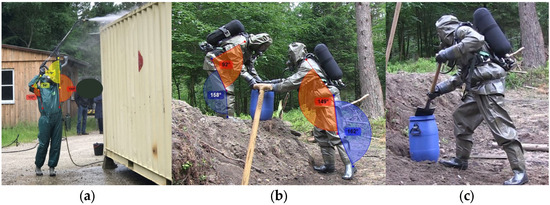
Figure 1.
Basic activities observed in the field: e.g., spraying (a), lifting (b) and shoveling (c).
Based on these insights, the study emphasized the need for targeted relief strategies, including the use of exoskeletal systems, external assistive devices, and optimized workplace organization. Manual handling techniques, such as team-based lifting and ergonomic lifting postures, can also reduce individual strain but require coordination and do not always align with operational constraints. Assistive tools like lifting aids, hoists and conveyor belts provide localized support, but stationary systems are often limited in the adaptability, flexibility and mobility required for dynamic military scenarios. These findings underscore the critical importance of flexible and wearable support systems, which can offer meaningful physical relief while preserving the mobility and operational effectiveness required in demanding CBRN environments [4].
Exoskeletons present a promising solution by offering active, task-specific support while preserving the mobility and adaptability necessary for CBRN missions. Unlike stationary assistive systems, wearable exoskeletons move with the user, providing continuous support without restricting movement or requiring fixed infrastructure. Exoskeletons can be classified based on various criteria, including the anatomical region they are designed to support, such as the shoulder, back, knee, or ankle. Another key distinction lies in their technical configuration, particularly the actuation mechanism, which may be passive or active. Additionally, exoskeletons differ in their structural relationship to the human body. Most systems are body-worn and closely aligned with the user’s anatomy, featuring mechanical structures that run in parallel with the corresponding body segments. In contrast, other designs operate at a greater distance from the body and do not follow a parallel anatomical configuration [5].
In addition to exoskeletons designed for general contexts such as manual handling or lifting tasks, several systems have been specifically developed with a focus on military applications, in order to increase endurance, amplify capabilities or reduce risk of injury by lowering muscular strain in critical areas such as the shoulders and lower back [6]. A recent review by Proud et al. [7] examining military and industrial exoskeletons identified 67 systems developed between 1990 and 2019, with the majority designed to assist lower limb movements during lifting tasks but also the hip, spine and shoulder joint. Most of these systems were active and demonstrated reductions in back muscle activity ranging from 15% to 54%, which highlights their potential for injury prevention and performance enhancement.
In the category of active exoskeletons, the Tactical Assault Light Operator Suit (TALOS), initiated by U.S. Special Operations Command, integrates powered support with advanced protective and life-support technologies, significantly enhancing operational performance and survivability. HULC by HEL is a lower-body system designed to reduce strain during load carriage, particularly in the legs. Asya by Aselsan incorporates externally mounted knee actuators to minimize inertial load, allowing for rapid movement with minimal resistance, and claims to enhance a soldier’s performance by up to 25%. Onyx by Lockheed Martin features terrain-adaptive control, enabling joint support based on user movement and environmental conditions [8]. Among passive systems, PowerWalk by Bionic Power utilizes knee movement during walking to harvest energy, generating up to 12 W and reducing the need to carry additional power supplies. Uprise by Mawashi aims to offload a significant portion of backpack weight (up to 80%) from the shoulders to the ground, thereby reducing musculoskeletal strain. OX, developed by the DST Group in Australia, is a lightweight system under 3 kg that uses flexible cable-based load transfer to offload weight efficiently during movement. K2 by JSCGB redistributes heavy loads, such as a 50 kg backpack, more evenly across the body, enhancing comfort and endurance [9].
Previous research on shoulder exoskeletons has primarily addressed occupational settings such as automotive manufacturing, construction, or logistics, where repetitive overhead work and static arm postures are dominant [10,11,12]. For example, the passive exoskeleton Paexo Shoulder (Ottobock, Duderstadt, Germany) uses a cable-based spring mechanism that transfers the weight of the arms to the hips via a lightweight frame, thereby reducing the load on the shoulder muscles during overhead tasks while allowing a high degree of mobility. Its compact and ergonomic design has been tested in various industrial settings and has shown significant reductions in shoulder muscle activity and perceived exertion [13,14]. Besides Paexo Shoulder, several other passive shoulder support systems with similar functional principles have been developed, such as the Skelex 360-XFR (Skelex, Den Haag, The Netherlands) [15], the EksoVest (Ekso Bionics, Richmond, CA, USA) [16], or the Airframe (Levitate Technologies, San Diego, CA, USA) [17], all of which aim to reduce musculoskeletal strain during repetitive overhead tasks.
In contrast to these passive solutions, active exoskeletons provide powered assistance that can be adapted to the movement dynamics of the user. The Stuttgart Exo-Jacket (Fraunhofer IPA, Stuttgart, Germany) integrates electric actuators with 12 degrees of freedom (DOF) to deliver task-specific shoulder support up to 40 Nm of torque, enabling a more flexible adaptation to different working postures and varying load conditions [18]. Another example is the S700 (ExoIQ, Hamburg, Germany), which employs active support by a pneumatic compressor, to assist the upper limbs during overhead tasks. A mobile application allows different assistive presets to be adjusted [19]. These active systems illustrate the trend toward more adaptive support concepts but also highlight challenges such as energy supply, control complexity, and system integration, especially in demanding operational environments such as military applications.
However, industrial scenarios are generally characterized by predictable tasks, relatively stable environments, and standardized workflows, which provide favorable conditions for exoskeleton integration. By contrast, military applications impose unique requirements on wearable assistive technologies. Soldiers must perform a wide range of dynamic and often unpredictable tasks, such as lifting, carrying, and tool operation, frequently under hazardous conditions. In particular, operations under CBRN threats involve the use of protective suits, which introduce additional physical burdens including restricted mobility, increased thermal load, and added weight. These constraints fundamentally differ from industrial contexts and demand exoskeleton designs that prioritize robustness, adaptability, and seamless compatibility with protective equipment.
Although several exoskeletons have been developed for military use, they primarily focus on lower body support and none of these systems are currently suitable for deployment in CBRN environments. A critical limitation is the absence of features that allow for decontamination or the seamless integration beneath protective suits that shield the user from hazardous exposure. Existing systems do not meet the specific demands of operations involving chemical, biological, radiological, or nuclear threats. This limitation reduces their practical relevance for scenarios where such protective measures are essential.
Therefore, this paper presents the design of a developed shoulder exoskeleton, that supports soldiers during upper body lifting tasks and is compatible with a CBRN protective suit. We conducted a biomechanical study to determine the exoskeletons potential for improving soldiers’ performance in demanding CBRN operations. In the present study, the system was evaluated under laboratory conditions without the use of protective gear, in order to isolate its biomechanical effects. Validation of its usability and unloading performance in combination with CBRN suits will be addressed in follow-up studies.
2. Concept and Design
2.1. Requirements
In CBRN scenarios, exoskeletons must comply with a unique and highly restrictive set of requirements, primarily dictated by the need to preserve the integrity of personal protective equipment (PPE). The combination of protective suits and assistive devices introduces unique challenges due to the sealed, gas-tight material, limited mobility, high internal humidity, and restricted field of vision. Furthermore, tasks often involve heavy respiratory equipment (e.g., self-contained breathing apparatus (SCBA)/powered air purifying respirator (PAPR)), frequent tool changes, and varying levels of protection, which significantly impact ergonomics and system compatibility [20]. Therefore, adaptability to individual users and task dynamics is also crucial. The exoskeleton should align closely with the natural kinematics of the wearer to avoid restricting movement during both primary tasks and incidental actions. Donning and doffing procedures must be error-resistant and uncomplicated to minimize preparation and recovery times, especially under conditions requiring rapid response. A fundamental design constraint is the incompatibility of protective suits with through-body interfaces. As a result, any supportive system must be either fully contained within the sealed environment of the suit or mounted externally without compromising the barrier function. Both options impose significant trade-offs: internal integration limits available space and demands compact, low-profile architectures, while external configurations raise challenges regarding contamination, decontamination, and secure attachment to the suit’s structural elements.
From a biomechanical and ergonomic perspective, the system should aim for a high metabolic efficiency. Given the already elevated physiological burden imposed by CBRN suits, including thermal load, restricted mobility, and additional mass, exoskeletons must offer support without further amplifying these stressors [21]. Achieving a favorable balance between assistance and system weight is critical. This necessitates the use of lightweight actuators with high power-to-weight ratios and efficient energy use. Additionally, passive mechanisms, which function without onboard power sources, are particularly advantageous, as they reduce system complexity, weight, and the need for recharging or refueling. Moreover, high dynamic responsiveness is essential. Actuators must be capable of rapidly adjusting to human movement to avoid resistance or lag, which could compromise safety or performance. In this regard, control interfaces must also be reconsidered under CBRN constraints. Systems requiring physical interaction across the protective barrier are not possible. Likewise, wireless solutions are generally excluded due to operational security (e.g., electromagnetic emission avoidance for stealth) and the potential for interference with sensitive or unknown materials in the environment. Ideally, control systems should function semi-autonomously, recognizing task patterns and adjusting support levels accordingly, thus reducing the need for manual input and ensuring consistent performance under varying operational conditions [22].
In summary, the exoskeleton must be lightweight, resistant to moisture and sweat, and seamlessly integrated into or under the protective suit without compromising its integrity. The system should offload shoulder and neck strain by transferring loads to the lower body, maintain postural stability, and allow unrestricted movement. Adaptive, joint-specific actuators that align with natural motion patterns can reduce energy consumption and enhance metabolic efficiency during mission-critical tasks [4].
2.2. Design of Exoskeleton for Shoulder Support
The developed functional prototype consists of a rigid base structure adapted to the human body and its movement patterns. It is pneumatically actuated, allowing for the support of highly dynamic motions. The system includes internal sensors to detect arm position and body orientation, enabling automatic adjustment of the support force based on a predefined force curve. Additionally, users can manually regulate the support intensity via a control interface located at the wrist, which also allows the entire system to be switched on or off.
The developed shoulder support exoskeleton (6.5 kg overall weight as shown in Figure 2) is designed to be compatible with CBRN protective equipment. The main functional components of the system are integrated within the protective suit, while external modules include a compressed air tank (0.97 kg, 1.1 L, 300 bar) and a control unit with battery supply (0.2 kg, 22.2V, 1200 mAh, SLS XTRON LiPo, SLS, Althegnenberg, Germany) are mounted outside the suit, allowing for easy access during operation. As a result, these components can be refilled or replaced without requiring the user to remove the protective suit. To enable this configuration, the system incorporates sealed pneumatic and electrical interface ports through the suit. In addition to the exoskeleton components, a dedicated mount on the rear frame allows the attachment of the oxygen cylinder required for CBRN operations, ensuring continuous respiratory support throughout the mission. With the integrated 300 bar, 1.1 L compressed air tank, the system enables approximately 1900 actuation cycles, corresponding to a practical usage duration of about 4 h.
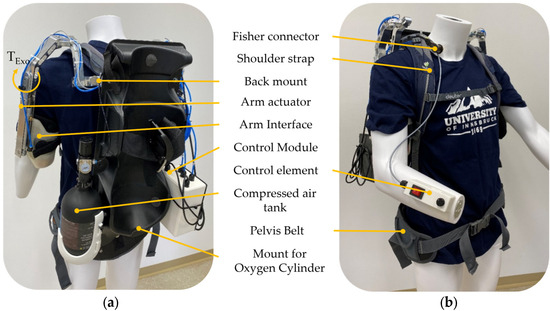
Figure 2.
Upper Body Exoskeleton (a) rear and (b) front view.
The exoskeleton with all main components but without the protective suit is depicted in Figure 2. The different parts are described in more detail below.
The shoulder exoskeleton comprises the following parts:
- (1)
- Actuation and Sensing—The actuation of the shoulder–neck exoskeleton is based on a proven pneumatic concept derived from the “Lucy” support system [23]. A pneumatic cylinder induces a linear stroke that generates torque (TExo) in the sagittal plane at the shoulder joint, depending on the shoulder flexion angle. The shoulder angle is measured using a rotary potentiometer integrated into the joint mechanism of the exoskeleton. The exoskeleton provides a peak assistance of approximately 8 Nm per shoulder joint at a system pressure of 5 bar, corresponding to an actuator force of 45 N.
- (2)
- Control Module—The control module is integrated as a compact and protected unit mounted laterally on the bracket for the compressed air cylinder. It includes three 9-volt batteries, a microcontroller (Arduino-based), solenoid valves, and an inertial measurement unit (IMU). All electrical and pneumatic connections are sealed to IP68 standard. The microcontroller processes input from the user interface and sensor data, including arm position from a potentiometer, torso inclination from the IMU, and internal system pressure from pressure sensors. A predefined force profile, modeled as a parabolic curve based on the biomechanical loading of the shoulder joint relative to arm angle [24], determines the level of support. Assistance begins at approximately 35° of arm elevation, increases to a peak at 90°, and then tapers off. The user can adjust the overall level of support via the potentiometer to tailor the assistance to task demands or personal preference. The overall control structure including the calculation of the reference pressure and the characteristics of the actuator are already described in detail by Otten et al. [23].
- (3)
- Back Structure—The back structure is designed to be as lightweight as possible while maintaining mechanical stability. A thin metal plate spans from the shoulder mechanism to the pelvic region, forming the main load path that transmits forces from the shoulders to the pelvis. The two-piece plate can be adjusted in length via an overlap and clamp mechanism, allowing for user-specific sizing. The upper segment is slightly thicker to enhance stiffness. Two fiberglass rods run parallel to the plate from the hip belt to the coupling interface, transferring the weight of respiratory gear, the compressed air tank, and control module into the pelvic region. The metal plate mimics the double-S shape of the human spine, providing a low-profile fit and facilitating upper-body mobility, including torso rotation. The structural design of the exoskeleton follows a backpack-like principle, allowing for intuitive and secure donning. A padded shoulder strap at the upper end of the metal backplate and a pelvic belt at the lower end ensure that the system’s weight is evenly distributed across the shoulders and hips.
- (4)
- Shoulder Mechanism and Degrees of Freedom—The shoulder mechanism offers two passive degrees of freedom (frontal and transversal rotation) and one actively actuated degree (sagittal rotation), allowing for high motion fidelity. To accommodate different users and enabling anthropometric fitting, the shoulder unit is fully adjustable in width and height.
- (5)
- Arm Interface—Assistance is transmitted to the user via a semi-open arm shell, 3D-printed from PLA, which distributes force broadly over the upper arm. The modular design allows complete replacement for different arm sizes. The shell is secured with a fastening strap and reinforced on both sides by durable textile bands with magnetic FIDLOCK® closures (www.fidlock.com), ensuring a stable fit during use. The inner lining consists of 2 cm thick PPI 10 polyurethane soft foam, selected for its pollutant-free, antibacterial, anti-allergenic, elastic, and moisture-resistant properties.
- (6)
- Coupling Interface—The coupling element enables quick attachment of the respiratory equipment to the exoskeleton. The breathing gas cylinder is mounted directly to the back frame. Pneumatic lines delivering compressed air to the actuator pass through sealed ports in the protective suit. A clamping nut secures the interface by clamping the suit material between the exoskeleton and the external coupling unit, maintaining airtight integrity in contaminated environments.
3. Evaluation
To evaluate the biomechanical effectiveness of the exoskeleton, a laboratory study was conducted using objective measurement techniques. The aim was to quantify both supportive and load-inducing effects on the wearer under standardized task conditions. A sequence of representative occupational activities was simulated in a controlled setting to model relevant operational demands. The primary objective was to demonstrate a measurable physiological relief during exoskeleton use without altering the motion kinematics of the user.
The following outcome parameters were assessed using biomechanical methods, with the respective assessment technique indicated in parentheses:
- Localized muscular unloading in target areas addressed by the exoskeleton (electromyography),
- Global physiological load or relief (spiroergometry),
- Alterations in movement patterns during task execution (motion capture) as well as
- Subjective perception of exertion or system-induced relief (questionnaire).
The study complied with the ethical principles outlined in the Declaration of Helsinki. Prior to participation, all individuals provided with written informed consent and were informed of their right to withdraw at any stage without consequences. Ethical approval was granted by the responsible institutional review board. Before testing, participants were thoroughly briefed on the purpose, procedures, and potential implications of using exoskeletal systems.
3.1. Participants
A total of 22 male participants (age 24 ± 3 years, height 189 ± 9 cm, mass 90 ± 14 kg) were recruited from the student population (soldiers) of Helmut Schmidt University. None of the participants had prior experience with exoskeletons or biomechanical testing procedures. All individuals were free from musculoskeletal disorders or any known movement limitations at the time of the study.
3.2. Biomechanical Measurement Instruments
Joint angles of the full body were recorded using the mobile Xsens Awinda inertial motion capture system (Movella Technologies, Enschede, The Netherlands) based on IMU technology. Surface electromyography (sEMG) was captured with a Myon 320 system (myon AG, Schwarzenberg, Switzerland). To evaluate muscle-specific unloading effects of the exoskeletons, relevant muscles were selected based on their functional involvement with the respective support type. Regarding the shoulder support exoskeleton, the m. anterior deltoid was identified as the primary target muscle. Electrode placement followed the SENIAM (Surface Electromyography for the Non-Invasive Assessment of Muscles) guidelines. Oxygen consumption was assessed using breath-by-breath gas analysis with the MetaMax 3B spiroergometry system (Cortex Biophysik, Leipzig, Germany), while heart rate was recorded simultaneously via a Polar H10 chest strap.
3.3. Measures
The dynamic tasks used for the biomechanical assessment were based on operational activities observed during the 2017 CBRN field study conducted by Linnenberg et al. [4]. To simulate these tasks under controlled laboratory conditions, a representative experimental setup was developed that closely replicated real-life operational demands.
The study was conducted using a within-subjects design with paired samples. All participants completed both conditions:
- Control—Condition without any exoskeleton as well as
- Intervention—Condition while using the shoulder-support exoskeleton (set to 100% assistance).
This crossover approach allowed each participant to serve as their own control, thereby reducing inter-individual variability and enabling direct comparison between supported and unsupported task execution.
Each participant performed the following two tasks with each two conditions (with and without support by the exoskeleton):
- Intermittent load tasks:
- (1)
- Lifting a 5 kg load from hip to head height (Figure 3a)
 Figure 3. Laboratory study, while performing (a) lifting task and (b) spraying task.
Figure 3. Laboratory study, while performing (a) lifting task and (b) spraying task.
- Continuous load tasks:
- (2)
- Combined task: spraying (without water) with a lance along horizontal path (swinging alternately from left to right) and vertical paths (lifting up and down) (Figure 3b)
The lifting task (1) is performed intermittently, with short 5 s pauses between repetitions. In contrast, task (2) is performed continuously without rest, simulating sustained effort in step with actual practice of soldiers in CBRN scenarios. Each task lasted five minutes to ensure a metabolic steady state during gas exchange analysis. For the lifting tasks, a fixed pace of 15 lifts per minute was maintained to ensure consistency across participants.
A five-minute seated rest period was provided between each task. Across both conditions (with and without exoskeleton), this resulted in a total of four trials per participant. The order of trials was randomized to mitigate sequence effects.
Following the physical tasks, participants completed a questionnaire to assess their subjective experience regarding the subjective perception of exertion by using a CR10 Borg Scale [25]. Therefore, participants were asked to indicate their perceived exertion level on the CR10 scale, ranging from 0 = no exertion at all to 10 = maximal exertion. Rating of perceived exertion (RPE) using the CR10 have been shown to be valid and reliable [26,27].
3.4. Data Analysis
Post-experiment, event markers were defined within the kinematic datasets using Xsens Analyze software (version 2025.0). For the lifting task, each movement cycle commenced at 0% with the participant in an upright posture just before grasping the weight and concluded at 100% upon returning to the upright position after placing the weight down. The vertical spraying task cycles initiated at the upper reversal point of the spray lance’s vertical trajectory and ended at the lower reversal point. Horizontal spraying task was captured as a single unit from start to finish. Consistent start and end events were established across all recorded conditions.
Subsequent data processing was conducted using MATLAB (version R2024a). Movement repetitions were segmented from start to end events and time-normalized to 101 data points per cycle. The first and last repetitions were excluded to mitigate boundary effects, and the remaining cycles were averaged. Electromyography (EMG) data underwent similar processing, including bandpass filtering between 20 and 220 Hz and full-wave rectification. EMG data were normalized to the peak amplitude of the respective task without the exoskeleton, with the peak value set to 100%, allowing for relative comparison across conditions.
For spiroergometric analysis, the final two minutes of each task were averaged to assess steady-state physiological responses. Parameters evaluated included heart rate and oxygen consumption normalized to body weight (V’O2/kg), providing insights into the metabolic demands associated with each task.
3.5. Statistical Analysis
The statistical evaluation was divided into the analysis of continuous and discrete data. Continuous data, derived from motion capture and electromyography (EMG), were analyzed using one-dimensional Statistical Parametric Mapping (SPM1D) [28]. Paired-sample t-tests were applied to assess statistically significant differences between the conditions (with vs. without exoskeleton). Significance was determined by exceeding a critical threshold, indicated by a red dashed line in the SPM output. Regions of significant difference were visualized by shaded areas within the test statistic curve.
Discrete data, including spiroergometry (oxygen uptake), heart rate, and subjective responses (perceived exertion and support via Borg scale (CR10)) were evaluated using paired-sample t-tests in SPSS (IBM SPSS Statistics, Version 29.0.1.0). A significance level of α = 0.05 was applied for all statistical tests.
4. Results
The following section presents the results of the biomechanical evaluation. For each of the two task scenarios, joint kinematics are analyzed first under both conditions (with and without exoskeleton). Based on the observed motion patterns, potential support effects provided by the exoskeleton are subsequently assessed through surface electromyography (EMG). Finally, the results of the subjective perception of exertion and the spiroergometric analysis are presented.
4.1. Lifting Task with Shoulder Exoskeleton
The lifting of the 5 kg load was initiated from an upright, vertical posture. The participants grasped the container at its side handles with a shoulder flexion of approximately 30–40% at around 30% of the movement cycle. The load was then lifted and placed onto a platform at a shoulder flexion of 80% between 50 and 60% of the cycle. Subsequently, the arms were lowered back to the starting position. As shown in Figure 4, a significant difference in arm positioning with and without the exoskeleton is evident at both the beginning and end of the cycle (α = 0.05, t* = 3.306, p = 0.005, p = 0.024) and at the moment of load placement in the elevated position (α = 0.05, t* = 3.306, p = 0.005, p = 0.027). During unloading, the arms were slightly more elevated when using the exoskeleton, likely due to the upward-directed support force generated by the system.
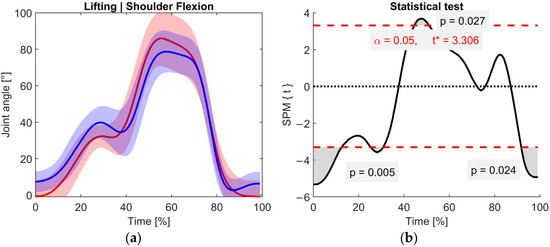
Figure 4.
(a) Averaged shoulder flexion angle without (blue) and with (red) shoulder support when lifting from hip to head height. (b) Two-sided, paired t-test SPM{t} with critical threshold (red dashed line).
When lowering the arms without the load, a significantly increased abduction angle was observed at 80% of the cycle (α = 0.05, t* = 3.282, p = 0.036) with the exoskeleton (Figure 5), as the support force initially had to be overcome. This resulted in a peak within the motion trajectory. While the arms were lowered, they temporarily deviated further from the body axis due to increased abduction, before being brought back in by pressing the arms against the exoskeleton’s arm segments.
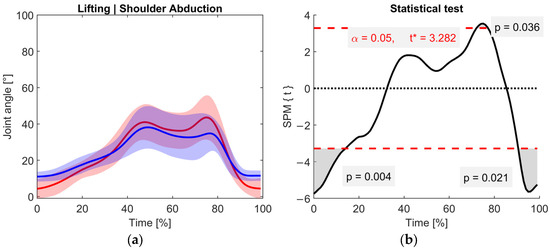
Figure 5.
(a) Averaged shoulder abduction angle without (blue) and with (red) shoulder support when lifting from hip to head height. (b) Two-sided, paired t-test SPM{t} with critical threshold (red dashed line).
The shoulder support system resulted in a significant reduction in activation of the anterior deltoid muscle (α = 0.05, t* = 3.757, p < 0.001), starting even before the load was lifted at 10% of the cycle and reaching a maximum reduction of −29.36 ± 17.61% at 40% of the cycle, corresponding to the moment the load was initially lifted to an elevated position. Muscle activity during the task, both with and without the exoskeleton, is presented in Figure 6.
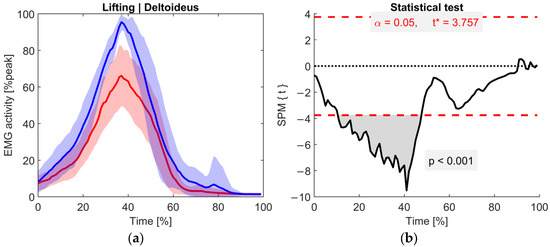
Figure 6.
(a) Averaged muscle activity of m. anterior deltoid without (blue) and with (red) shoulder support when lifting from hip to head height. (b) Two-sided, paired t-test SPM{t} with critical threshold (red dashed line).
4.2. Horizontal Spraying Task with Shoulder Exoskeleton
During the horizontal spraying task, the arms were held in an elevated position between 70° and 90° of shoulder flexion throughout the entire movement, resulting in a predominantly semi-static and sustained load in the sagittal plane. As shown in Figure 7, participants held the spray lance significantly higher on average while wearing the exoskeleton (α = 0.05, t* = 3.488, p = 0.001), likely due to the upward-directed support force. Over the course of the cycle, a gradual decrease in shoulder flexion indicates a slight lowering of the arms, suggesting compensatory movement in response to muscular fatigue. This fatigue-related trend was observed both with and without the exoskeleton.
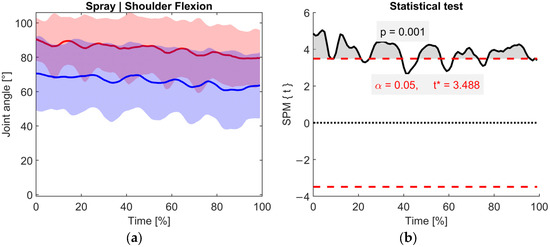
Figure 7.
(a) Averaged shoulder flexion angle without (blue) and with (red) shoulder support when horizontal spraying. (b) Two-sided, paired t-test SPM{t} with critical threshold (red dashed line).
Throughout the entire movement task, muscle load was significantly reduced by approximately −40.81 ± 16.62% (α = 0.05, t* = 4.102, p < 0.001), indicating that the shoulder exoskeleton provided considerably greater support compared to the dynamic lifting task (Figure 8). Unlike dynamic movements, where support must be modulated based on joint angles, the exoskeleton does not need to adapt to such varying requirements. Instead, the maximum supportive force is applied consistently across the full movement cycle, allowing the arms to be effectively “rested” in the arm shells.
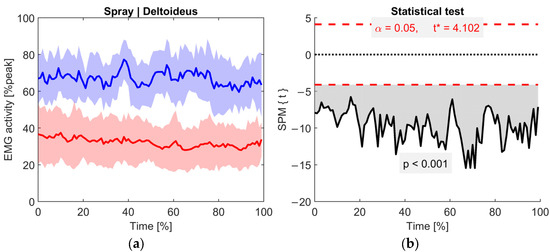
Figure 8.
(a) Averaged muscle activity of m. anterior deltoid without (blue) and with (red) shoulder support when horizontal spraying. (b) Two-sided, paired t-test SPM{t} with critical threshold (red dashed line).
4.3. Vertical Spraying Task with Shoulder Exoskeleton
In contrast to horizontal spraying, vertical spraying is characterized by a dynamic movement in the sagittal plane. The movement cycle begins at the upper end of the spraying motion with a shoulder flexion of 70° without the exoskeleton and proceeds repetitively to the lower end and back to the starting position. When wearing the exoskeleton, a significantly greater flexion angle was achieved (α = 0.05, t* = 2.844, p = 0.030), similar to the horizontal spraying task, enabling a wider range of motion. The movement trajectory in the shoulder joint, with and without the exoskeleton, is shown in Figure 9.
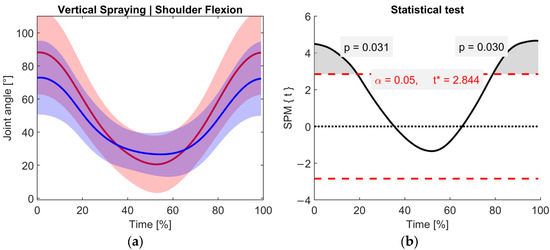
Figure 9.
(a) Averaged shoulder flexion angle without (blue) and with (red) shoulder support when vertical spraying. (b) Two-sided, paired t-test SPM{t} with critical threshold (red dashed line).
Figure 10 illustrates that the shoulder exoskeleton significantly reduced the muscle activity of the m. anterior deltoid during the downward and upward movement of the spray wand by a maximum of −37.1 ± 20.18% (α = 0.05, t* = 3.511, p < 0.001). Due to the reversal of movement at the lower turning point (40–50% of the cycle), no significant difference was observed at this specific point.
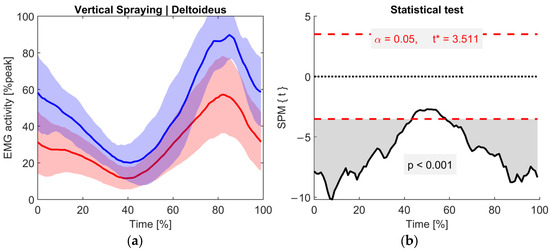
Figure 10.
(a) Averaged muscle activity of m. anterior deltoid without (blue) and with (red) shoulder support when vertical spraying. (b) Two-sided, paired t-test SPM{t} with critical threshold (red dashed line).
4.4. Subjective Strain Perception
The analysis of subjective received perception of exertion (RPE) using the Borg (CR10) scale confirmed the findings of the objectively measured parameters. A significant reduction in perceived exertion was reported across the examined tasks (Figure 11). The greatest difference between conditions with and without the exoskeleton was observed during the spraying task, with a 38% reduction in perceived exertion (mean difference 2.167 ± 1.465, p < 0.001), followed by the lifting task, which showed a 31% reduction (mean difference 1.667 ± 1.188, p < 0.001). In contrast, the differences were less marked for the lifting task, where peak strain occurs only briefly and is followed by a recovery phase before the next repetition.
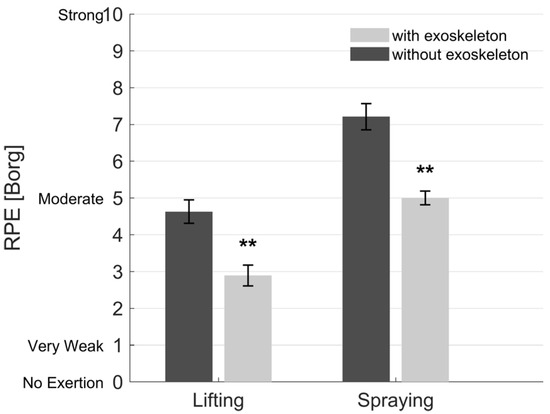
Figure 11.
Intervention effects on ratings of perceived exertion for lifting and spraying tasks. Note that ** denotes significant differences (p < 0.01) from the control condition (without exoskeleton).
4.5. Workload Analysis
In addition to muscular and kinematic parameters, heart rate cardiovascular strain was evaluated using spiroergometry. During both the lifting and spraying tasks, the exoskeleton condition resulted in significantly lower global physiological effort as indicated by heart rate and oxygen uptake per kilogram of body weight. For the lifting task, mean heart rate was reduced by significantly 4.9% (with exoskeleton (WE): 97.87 min−1; without exoskeleton (WOE) 102.87 min−1; p = 0.012), and oxygen consumption decreased by 8.2% (WE: 9.97 mL/kg/min; WOE: 10.86 mL/kg/min; p = 0.043) but without significance (Figure 12). Similar effects were observed during the spraying task, with a significant reduction in heart rate of 6.3% (WE: 100.02 min−1; WOE: 106.79 min−1; p < 0.001), and a significant decrease in oxygen consumption of 6.5% (WE: 10.24 mL/kg/min; WOE: 10.95 mL/kg/min; p = 0.007). These findings indicate a consistent reduction in cardiovascular workload when using the shoulder support exoskeleton across different task profiles.
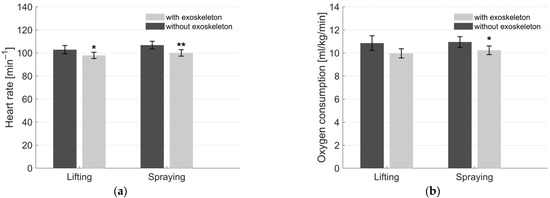
Figure 12.
(a) Mean heart rate and (b) oxygen consumption for lifting and spraying tasks. Note that *, ** denotes significant differences (p < 0.05, p < 0.01) from the control condition (without exoskeleton).
When using the equation of Garby and Astrup [29], the relative energy expenditure rates (kcal/min/kg) can be estimated [30]. The results showed differences of 8.66% for the lifting task (WE: 0.199 kcal/kg/min; WOE: 0.218 kcal/kg/min; p = 0.059) and 6.96% for the spraying tasks (WE: 0.208 kcal/kg/min; WOE: 0.224 kcal/kg/min; p = 0.021)
5. Discussion
In this controlled laboratory study, the influence of the shoulder exoskeleton on joint kinematics and its potential to reduce physiological strain was evaluated. The results demonstrate that the exoskeleton can reduce physical strain during movement tasks with different dynamic demands.
The results are discussed in detail hereafter, emphasizing the exoskeleton’s assistive performance, user feedback, and potential directions for future improvements and use.
5.1. Biomechanical Parameters
The results of the kinematic analysis emphasize that use of the exoskeleton is accompanied by minor kinematic adaptations during the execution of certain movements. It is important to note that only shoulder motion in the sagittal and frontal planes was analyzed in this study, as these are the most likely to be affected due to the system’s mechanical configuration and support mechanism. Whether compensatory movement patterns occur in other body joints remains to be explored through extended analysis of the existing motion capture data.
Regarding the joint trajectories during the spraying tasks, the arms were raised in a slightly more elevated position particularly in the horizontal variant, where participants maintained a higher arm posture throughout the cycle. Without the exoskeleton, participants instinctively adopted a lower arm position to minimize muscular effort, whereas with the support system, higher arm postures were sustained more easily, indicating a reduction in perceived exertion, which could lower muscular fatigue and improve physical endurance during overhead tasks [31]. The slightly more elevated arm posture, facilitated by the upward support force of the exoskeleton, may offer functional advantages in practice by allowing users to maintain ergonomically favorable working positions for extended periods. Although the wider range of arm lifting movement observed during the spraying task could be interpreted as beneficial for certain overhead work scenarios, Park et al. [32] found that users were less satisfied when there was a greater deviation from the original arm movement. In contrast to the spraying tasks, the lifting task showed significantly reduced shoulder flexion and abduction angles at the initiation and the end of the motion. Particularly during the lowering of the arms, the users had to overcome the upward-directed support force, which led to slightly increased frontal and sagittal shoulder angles, which is consistent with other exoskeleton studies [33]. Shortly before the end of the movement, the support force dropped abruptly to 0 N at around 35° of shoulder flexion (see Section 2.2, Control Module). As a result of the built-up counterforce and the arms' inertia, both flexion and abduction angles slightly undershoot their endpoints compared to the movement without exoskeleton. This suggests that the force profile (parabolic curve, set to peak 100% assistance) of the system is not constant across all joint positions and may need to be further optimized to better accommodate transitions in highly dynamic tasks. From a development perspective, further refinement of the exoskeleton’s control algorithm may be beneficial in order to optimize this degree of freedom. In particular, a smoother or more gradual control response during the downward motion could help better accommodate the arm's deceleration phase. This would reduce the need for compensatory neuromuscular effort by the user to overcome abrupt changes in support force. Recent studies highlight the potential of intelligent control approaches [19], such as deep learning and reinforcement learning, to improve human–machine interaction by enabling adaptive, user-specific assistance during complex movement phases [34], despite their current relevance being primarily limited to research contexts. The parameter settings and switching thresholds applied in this study were derived from preliminary pilot experiments and heuristic evaluations to ensure stable system operation and user safety during task execution. A formal stability and convergence analysis of the parameter identification method was beyond the scope of the present work and is planned as part of future investigations.
To evaluate unloading effects, tasks with varying movement characteristics were investigated. Reductions in muscular activity were observed during the symmetric, discrete lifting task as well as during repetitive movements such as spraying with a lance. The results of the biomechanical analysis indicate that the active shoulder exoskeleton effectively reduces muscular workload in the m. anterior deltoid during both lifting and spraying tasks. This reduction was most prominent during the horizontal spraying task, where participants maintained elevated arm positions for an extended duration. The continuous assistance provided by the exoskeleton appears to support the arm against gravity, allowing the user to “rest” their upper limbs in the arm shells. As a result, muscular effort was significantly decreased across the entire task cycle, suggesting a strain benefit especially in tasks characterized by static or semi-static shoulder elevation. Similar decreases in m. anterior deltoid activity have been reported for occupational shoulder exoskeletons during overhead tasks [35]. For example, Ding et al. [36] observed a reduction in m. deltoid anterior activation of 25% during both repetitive and sustained overhead simulated work. Also higher reduction can be found. Mänttäri et al. [37] likewise reported a 32% reduction shoulder muscle activity when using an exoskeleton, with some studies even observing decreases of up to 81% [38]. Variations in these results can be attributed to differences in experimental setups, including task type (such as lifting or drilling), the exoskeleton model used, tool weight, and the participants’ level of experience.
5.2. Metabolic Parameters
The findings of the spiroergometric analysis provide further evidence of the physiological relief provided by the shoulder exoskeleton. Both heart rate and oxygen consumption per unit body weight were reduced across tasks, suggesting that the exoskeleton not only lowers local muscular strain but also contributes to an overall reduction in systemic workload. Although the reduction in heart rate was significant across all tasks, the metabolic cost was only significant during the spraying task, likely due to the sustained semi-static muscular activity associated with arm elevation, which the exoskeleton effectively mitigates. The lower metabolic demand observed may have practical relevance in occupational settings where cumulative cardiovascular load contributes to fatigue and physical strain. These results align with prior research emphasizing the importance of assessing both muscular and cardiorespiratory parameters to evaluate the holistic impact of assistive wearable systems. Schmalz et al. [39] found a reduction of 6% in heart rate and 11% of oxygen consumption during an head-height screwing task with the Paexo exoskeleton. Greater reduction were found by Maurice et al. [13] during an overhead drilling task. Both oxygen consumption and heart rate were significantly affected by the exoskeleton, whereas oxygen consumption was lower by 33% and heart rate by 19% on average. In addition, they analyzed changes in metabolic parameter over task duration. Accordingly, an increase in heart rate by 56% and in oxygen consumption by 37% between the beginning and end of the tasks were observed, whereas the increase reaches 65% and 65% without the exoskeleton, respectively.
5.3. Subjective Perceived Exertion
The objective reduction in local (EMG) and global (heart rate, energy consumption) workload was further supported by participants’ subjective ratings. Using the Borg scale, participants consistently reported a perceived reduction in exertion across all tasks when using the exoskeleton. The results support the objective data and highlight the practical relevance of the shoulder exoskeleton from the user’s perspective. Particularly in tasks involving arm elevation with low dynamics (no motion in sagittal plane during horizontal spraying), the exoskeleton’s effect was clearly perceived. Without assistance, several individuals noted that they struggled to complete the spraying task and were close to terminating it prematurely due to physical exhaustion. In contrast, with exoskeleton support, the same task was perceived as significantly less demanding, and participants were able to complete it without considering early termination. The continuous upward support provided by the system likely contributes to the reduction in perceived fatigue. During the discrete lifting task, the limited duration of muscular activation in each repetition may explain the comparatively smaller difference in subjective strain. Overall, the participants’ perceptions emphasize the potential of active exoskeletons not only to reduce physical load but also to mitigate the feeling of fatigue during physically demanding work.
5.4. Limitations of the Study
While the present study provides valuable insights into the biomechanical effects of a shoulder support exoskeleton under controlled laboratory conditions, several limitations must be acknowledged. First, in order to isolate the specific effects of the exoskeleton itself and potential interactions with the suit, such as movement restrictions, thermal load, or interface friction, the study intentionally excluded the originally intended integration of the exoskeleton with a CBRN protective suit. Furthermore, the spraying task was performed with a lance without water flow in order to standardize the experimental setup and to ensure feasibility within the controlled laboratory environment. While this approach allowed us to isolate the exoskeleton’s support during arm elevation, it does not fully replicate the external forces present in real spraying operations, such as reaction forces from water pressure or the additional mass of the fluid. These factors likely increase shoulder loading and may alter the degree of unloading provided by the system. A follow-up study in field with complete equipment is planned to investigate how the protective gear may influence the system’s unloading performance and overall usability under realistic operational conditions. Second, the study focused primarily on short-term physiological effects, particularly joint kinematics and muscle activity. Long-term adaptation processes, including potential changes in motor control strategies, muscular fatigue, or compensatory movement patterns, were not addressed. Future studies should investigate the prolonged use of shoulder exoskeletons over extended work shifts or multiple days to assess cumulative benefits or potential drawbacks such as discomfort, muscle deconditioning, or localized pressure points. Third, the kinematic analysis was limited to the shoulder joint in the sagittal and frontal planes. While this focus was appropriate given the design and function of the exoskeleton, movements in other joints, such as the spine, elbow, or lower limbs, were not examined. It remains unclear whether the support system might lead to compensatory movement patterns in other body regions, which could in turn introduce new sources of strain. Additionally, regarding the analysis of muscle activity, while the anterior deltoid was chosen as the primary focus of analysis, other agonists and stabilizers (e.g., trapezius, rotator cuff, or trunk muscles) also contribute to overhead movements and may be affected by the exoskeleton. A comprehensive full-body analysis would be beneficial in future research to evaluate potential biomechanical trade-offs. Fourth, a standardized load of 5 kg was used to ensure comparability and participant safety. While this weight represents a moderate physical demand, CBRN scenarios may involve higher or more variable loads. Future studies should therefore extend the evaluation to heavier tools and load conditions to more comprehensively assess the exoskeleton’s applicability in operational environments. Finally, the study sample consisted of healthy and young participants (soldier students) with no existing musculoskeletal impairments. It is not yet known how these findings apply to people with pre-existing shoulder complaints or different physical capacities. Future investigations should aim to include a broader range of user profiles, including older subjects or those at elevated risk for shoulder musculoskeletal disorders, to assess both effectiveness and user acceptance in diverse populations. This also includes the use of exoskeletons by soldiers in CBRN applications. Aspects such as long-term usability, durability, and convenience in operational environments were not investigated. These factors may influence the occurrence of potential new problems during extended deployment. Upcoming studies should therefore address prolonged use scenarios and assess how the system’s adaptability and comfort evolve over time under realistic working conditions. A field study is already planned to assess acceptance in practical work environments under operational conditions.
6. Conclusions
The results of this study demonstrate the potential of active shoulder exoskeletons to significantly reduce muscular strain during physically demanding upper limb tasks, particularly those involving prolonged arm elevation. Originally developed for soldiers operating in CBRN environments, the exoskeleton was specifically designed to integrate with protective suits. The positive effects observed in this study highlight its potential to support military personnel performing strenuous tasks in hazardous, contaminated environments, without compromising protective integrity. However, the present evaluation was carried out without protective gear under controlled laboratory conditions. The observed benefits therefore reflect the device’s fundamental unloading capabilities, but further research is needed to validate these effects and the practical compatibility under real CBRN scenarios.
Beyond this specific application, the fundamental support principle of the system can be extended to civilian contexts. The observed reduction in m. anterior deltoid activity across both semi-static and dynamic tasks suggests potential for broader implementation in occupations involving overhead work, such as logistics, painting, electrical installation or warehousing. In particular, the system proved especially effective during sustained tasks like spraying, where static elevated arm postures are required over extended periods.
These findings emphasize the value of wearable assistive technologies in reducing physical fatigue and preventing work-related musculoskeletal disorders (MSDs), especially in situations where conventional ergonomic interventions or automation are impractical. Proper task analysis, individual adjustment, and user training remain essential to ensure safe and effective integration. Future research should also address the long-term effects on joint mechanics and work performance to support sustainable implementation in both military and civilian settings.
Author Contributions
Conceptualization and methodology, T.S. and R.W.; investigation, T.S.; writing—original draft preparation, T.S.; writing—review and editing, T.S. and R.W.; visualization, T.S.; and supervision, R.W. All authors have read and agreed to the published version of this manuscript.
Funding
This research, in particular the evaluation study, was funded by dtec.bw—Digitalization and Technology Research Center of the Bundeswehr [project KIKU]. Dtec.bw is funded by the European Union—Next Generation EU. The development of the exoskeleton was funded by Bundeswehr Research Institute for Protective Technologies and NBC Protection [project: Entlastung beim Tragen von CBRN-Schutzausrüstung], grant number E/E590/IZ014/HF120.
Institutional Review Board Statement
The study was conducted according to the guidelines of the Declaration of Helsinki and approved by the Ethics Committee of the Department of Psychology of the Helmut–Schmidt University. 2024_011. 29 August 24.
Informed Consent Statement
Informed consent was obtained from all the participants involved in the study.
Data Availability Statement
The original contributions presented in the study are included in the article, further inquiries can be directed to the corresponding author.
Acknowledgments
The authors created a fully articulated text version. This fully articulated text was reviewed by ChatGPT-4o for clarity while keeping all citations and links. The edited output of ChatGPT was then again reviewed and edited by the authors. ChatGPT was not used to generate the text. The authors would like to thank the Chair of Production Technology, Institute of Mechatronics, University of Innsbruck, for providing the exoskeleton. In addition, we would like to acknowledge the cooperation and support of the Bundeswehr Research Institute for Protective Technologies and CBRN Protection (WIS).
Conflicts of Interest
The authors declare no conflicts of interest.
References
- Orr, R.; Pope, R.; Lopes, T.J.A.; Leyk, D.; Blacker, S.; Bustillo-Aguirre, B.S.; Knapik, J.J. Soldier Load Carriage, Injuries, Rehabilitation and Physical Conditioning: An International Approach. Int. J. Environ. Res. Public Health 2021, 18, 4010. [Google Scholar] [CrossRef] [PubMed]
- Farris, D.J.; Harris, D.J.; Rice, H.M.; Campbell, J.; Weare, A.; Risius, D.; Armstrong, N.; Rayson, M.P. A systematic literature review of evidence for the use of assistive exoskeletons in defence and security use cases. Ergonomics 2023, 66, 61–87. [Google Scholar] [CrossRef]
- Sammito, S.; Hadzic, V.; Karakolis, T.; Kelly, K.R.; Proctor, S.P.; Stepens, A.; White, G.; Zimmermann, W.O. Risk factors for musculoskeletal injuries in the military: A qualitative systematic review of the literature from the past two decades and a new prioritizing injury model. Mil. Med. Res. 2021, 8, 66. [Google Scholar] [CrossRef] [PubMed]
- Linnenberg, C.; Klabunde, J.; Hagner, K.; Weidner, R. Exoskeletons for Unarmed Military Use: Requirements and Approaches to Support Human Movements Using an Example of Protection Against Unknown CBRN Dangers. In Wearable Robotics, Proceedings of the 5th International Symposium on Wearable Robotics, WeRob2020, and of WearRAcon Europe 2020, Online, 13–16 October 2020; International Symposium on Wearable, Robotics; Moreno, J.C., Ed.; Springer International Publishing AG: Cham, Switzerland, 2022; pp. 535–539. ISBN 978-3-030-69547-7. [Google Scholar]
- Weidner, R.; Linnenberg, C.; Hoffmann, N.; Prokop, G.; Edwards, V. Exoskelette für den industriellen Kontext: Systematisches Review und Klassifikation. In Digitale Arbeit, Digitaler Wandel, Digitaler Mensch? 66. Kongress der Gesellschaft für Arbeitswissenschaft, Berlin; Gesellschaft für Arbeitswissenschaft e.V., Ed.; GfA-Press: Berlin, Germany, 2020. [Google Scholar]
- Cooper, R.A.; Smolinski, G.; Candiotti, J.L.; Satpute, S.; Grindle, G.G.; Sparling, T.L.; Nordstrom, M.J.; Yuan, X.; Symsack, A.; Dae Lee, C.; et al. Current State, Needs, and Opportunities for Wearable Robots in Military Medical Rehabilitation and Force Protection. Actuators 2024, 13, 236. [Google Scholar] [CrossRef] [PubMed]
- Proud, J.K.; Lai, D.T.H.; Mudie, K.L.; Carstairs, G.L.; Billing, D.C.; Garofolini, A.; Begg, R.K. Exoskeleton Application to Military Manual Handling Tasks. Hum. Factors 2022, 64, 527–554. [Google Scholar] [CrossRef]
- Leova, L.; Cubanova, S.; Kutilek, P.; Volf, P.; Hejda, J.; Hybl, J.; Stastny, P.; Vagner, M.; Krivanek, V. Current State and Design Recommendations of Exoskeletons of Lower Limbs in Military Applications. In Modelling and Simulation for Autonomous Systems: 8th International Conference, MESAS 2021, Virtual Event, 13–14 October 2021, Revised Selected Papers, 1st ed.; Mazal, J., Fagiolini, A., Vasik, P., Turi, M., Bruzzone, A., Pickl, S., Neumann, V., Stodola, P., Eds.; Springer International Publishing: Cham, Switzerland, 2022; pp. 452–463. ISBN 978-3-030-98259-1. [Google Scholar]
- Jia-Yong, Z.; Ye, L.I.; Xin-Min, M.O.; Chong-Wei, H.A.; Xiao-Jing, M.; Qiang, L.I.; Yue-Jin, W.; Ang, Z. A preliminary study of the military applications and future of individual exoskeletons. J. Phys. Conf. Ser. 2020, 1507, 102044. [Google Scholar] [CrossRef]
- Tian, J.; Wei, B.; Luo, S.; Yang, C.; Chen, C.; Liu, Y.; Feng, J.; Li, P.; Zhu, H.; Yi, C. A Systematic Review of Occupational Shoulder Exoskeletons for Industrial Use: Mechanism Design, Actuators, Control, and Evaluation Aspects. Actuators 2024, 13, 501. [Google Scholar] [CrossRef]
- Carnazzo, C.; Spada, S.; Ghibaudo, L.; Eaton, L.; Fajardo, I.; Zhu, S.; Cavatorta, M.P. Exoskeletons in Automotive Industry: Investigation into the Applicability Across Regions. In Proceedings of the 21st Congress of the International Ergonomics Association (IEA 2021), Online, 13–18 June 2021, Volume III: Sector Based Ergonomics; Congress of the International Ergonomics Association; Black, N.L., Neumann, W.P., Noy, I., Eds.; Springer International Publishing: Cham, Switzerland, 2021; pp. 398–406, ISBN 978-3-030-74608-7. [Google Scholar]
- Reyes, F.A.; Shuo, D.; Yu, H. Shoulder-Support Exoskeletons for Overhead Work: Current State, Challenges and Future Directions. IEEE Trans. Med. Robot. Bionics 2023, 5, 516–527. [Google Scholar] [CrossRef]
- Maurice, P.; Camernik, J.; Gorjan, D.; Schirrmeister, B.; Bornmann, J.; Tagliapietra, L.; Latella, C.; Pucci, D.; Fritzsche, L.; Ivaldi, S.; et al. Objective and Subjective Effects of a Passive Exoskeleton on Overhead Work. IEEE Trans. Neural Syst. Rehabil. Eng. 2020, 28, 152–164. [Google Scholar] [CrossRef]
- Fritzsche, L.; Galibarov, P.E.; Gärtner, C.; Bornmann, J.; Damsgaard, M.; Wall, R.; Schirrmeister, B.; Gonzalez-Vargas, J.; Pucci, D.; Maurice, P.; et al. Assessing the efficiency of exoskeletons in physical strain reduction by biomechanical simulation with AnyBody Modeling System. Wearable Technol. 2021, 2, e6. [Google Scholar] [CrossRef]
- Mänttäri, S.; Rauttola, A.-P.; Halonen, J.; Karkulehto, J.; Säynäjäkangas, P.; Oksa, J. Effects of an exoskeleton on muscle activity in tasks requiring arm elevation: Part I—Experiments in a controlled laboratory setting. Work 2024, 77, 1179–1188. [Google Scholar] [CrossRef]
- Rafique, S.; Rana, S.M.; Bjorsell, N.; Isaksson, M. Evaluating the advantages of passive exoskeletons and recommendations for design improvements. J. Rehabil. Assist. Technol. Eng. 2024, 11, 20556683241239875. [Google Scholar] [CrossRef]
- Gillette, J.C.; Saadat, S.; Butler, T. Electromyography-based fatigue assessment of an upper body exoskeleton during automotive assembly. Wearable Technol. 2022, 3, e23. [Google Scholar] [CrossRef] [PubMed]
- Ebrahimi, A. Stuttgart Exo-Jacket: An exoskeleton for industrial upper body applications. In Proceedings of the 2017 10th International Conference on Human System Interactions (HSI), Proceedings: International Hall, University of Ulsan, Ulsan, Republic of Korea, 17–19 July 2017; IEEE: Piscataway, NJ, USA, 2017; pp. 258–263, ISBN 978-1-5090-4688-1. [Google Scholar]
- Nagwekar, R.; Sonnenschein, J.; Latifi, S.M.M.; Gökay, R.; Weidner, R. Biomechanical Study of Passive and Active Exoskeletons for Analyzing the Dependent Parameters for an Intelligent Control System. In Proceedings of the 11th International Conference on Control, Automation and Robotics (ICCAR), Kyoto, Japan, 18–20 April 2025; IEEE: Piscataway, NJ, USA, 2025; pp. 252–257, ISBN 979-8-3315-2026-7. [Google Scholar]
- Shuvo, I.I.; Dolez, P.I. Design of a military protective suit against biological agents. In Functional and Technical Textiles; Maity, S., Singha, K., Pandit, P., Eds.; Woodhead Publishing: Cambridge, UK, 2023; pp. 141–176. ISBN 978-0-323-91593-9. [Google Scholar]
- Harmata, W.; Wachna, P. Soldier protection in the defence system against weapons of mass destruction. Bull. Mil. Univ. Technol. 2024, 73, 21–38. [Google Scholar] [CrossRef]
- Preethichandra, D.M.G.; Piyathilaka, L.; Sul, J.-H.; Izhar, U.; Samarasinghe, R.; Arachchige, S.D.; de Silva, L.C. Passive and Active Exoskeleton Solutions: Sensors, Actuators, Applications, and Recent Trends. Sensors 2024, 24, 7095. [Google Scholar] [CrossRef]
- Otten, B.; Weidner, R.; Argubi-Wollesen, A. Evaluation of a Novel Active Exoskeleton for Tasks at or Above Head Level. IEEE Robot. Autom. Lett. 2018, 3, 2408–2415. [Google Scholar] [CrossRef]
- Wollesen, A.A.; Schubert, T.; Mattes, K.; Weidner, R. Assessment of shoulder asymmetry for the design of an exoskeleton. In Proceedings of the Congress of the European College of Sport Science (ECSS), Dublin, Ireland, 4–7 July 2018. [Google Scholar]
- Foster, C.; Florhaug, J.A.; Franklin, J.; Gottschall, L.; Hrovatin, L.A.; Parker, S.; Doleshal, P.; Dodge, C. A new approach to monitoring exercise training. J. Strength Cond. Res. 2001, 15, 109–115. [Google Scholar]
- Herman, L.; Foster, C.; Maher, M.A.; Mikat, R.P.; Porcari, J.P. Validity and reliability of the session RPE method for monitoring exercise training intensity. S. Afr. J. Sports Med. 2006, 18, 14. [Google Scholar] [CrossRef]
- Haddad, M.; Stylianides, G.; Djaoui, L.; Dellal, A.; Chamari, K. Session-RPE Method for Training Load Monitoring: Validity, Ecological Usefulness, and Influencing Factors. Front. Neurosci. 2017, 11, 612. [Google Scholar] [CrossRef]
- Pataky, T.C. One-dimensional statistical parametric mapping in Python. Comput. Methods Biomech. Biomed. Eng. 2012, 15, 295–301. [Google Scholar] [CrossRef]
- Garby, L.; Astrup, A. The relationship between the respiratory quotient and the energy equivalent of oxygen during simultaneous glucose and lipid oxidation and lipogenesis. Acta Physiol. Scand. 1987, 129, 443–444. [Google Scholar] [CrossRef] [PubMed]
- Kipp, S.; Byrnes, W.C.; Kram, R. Calculating metabolic energy expenditure across a wide range of exercise intensities: The equation matters. Appl. Physiol. Nutr. Metab. 2018, 43, 639–642. [Google Scholar] [CrossRef] [PubMed]
- De Bock, S.; Rossini, M.; Lefeber, D.; Rodriguez-Guerrero, C.; Geeroms, J.; Meeusen, R.; De Pauw, K. An Occupational Shoulder Exoskeleton Reduces Muscle Activity and Fatigue During Overhead Work. IEEE Trans. Biomed. Eng. 2022, 69, 3008–3020. [Google Scholar] [CrossRef]
- Park, S.; Jung, M.K.; Kim, K.; Lim, H.; Yoon, J.; Hyun, D.J. Correlations Between Biomechanical Variables and Subjective Measures of Satisfaction While Using a Passive Upper-Limb Exoskeleton for Overhead Tasks in the Field. IEEE Trans. Human-Mach. Syst. 2025, 55, 176–184. [Google Scholar] [CrossRef]
- McFarland, T.C.; McDonald, A.C.; Whittaker, R.L.; Callaghan, J.P.; Dickerson, C.R. Level of exoskeleton support influences shoulder elevation, external rotation and forearm pronation during simulated work tasks in females. Appl. Ergon. 2022, 98, 103591. [Google Scholar] [CrossRef]
- Mashud, G.; Hasan, S.K.; Alam, N. Advances in Control Techniques for Rehabilitation Exoskeleton Robots: A Systematic Review. Actuators 2025, 14, 108. [Google Scholar] [CrossRef]
- Pinho, J.P.; Forner-Cordero, A. Shoulder muscle activity and perceived comfort of industry workers using a commercial upper limb exoskeleton for simulated tasks. Appl. Ergon. 2022, 101, 103718. [Google Scholar] [CrossRef]
- Ding, S.; Reyes Francisco, A.; Li, T.; Yu, H. A novel passive shoulder exoskeleton for assisting overhead work. Wearable Technol. 2023, 4, e7. [Google Scholar] [CrossRef]
- Mänttäri, S.; Rauttola, A.-P.; Halonen, J.; Karkulehto, J.; Säynäjäkangas, P.; Oksa, J. Effects of upper-limb exoskeleton on muscle activity in tasks requiring arm elevation: Part II—In-field experiments in construction industry settings. Work 2024, 79, 753–763. [Google Scholar] [CrossRef] [PubMed]
- van Engelhoven, L.; Poon, N.; Kazerooni, H.; Rempel, D.; Barr, A.; Harris-Adamson, C. Experimental Evaluation of a Shoulder-Support Exoskeleton for Overhead Work: Influences of Peak Torque Amplitude, Task, and Tool Mass. IISE Trans. Occup. Ergon. Hum. Factors 2019, 7, 250–263. [Google Scholar] [CrossRef]
- Schmalz, T.; Schändlinger, J.; Schuler, M.; Bornmann, J.; Schirrmeister, B.; Kannenberg, A.; Ernst, M. Biomechanical and Metabolic Effectiveness of an Industrial Exoskeleton for Overhead Work. Int. J. Environ. Res. Public Health 2019, 16, 4792. [Google Scholar] [CrossRef]
Disclaimer/Publisher’s Note: The statements, opinions and data contained in all publications are solely those of the individual author(s) and contributor(s) and not of MDPI and/or the editor(s). MDPI and/or the editor(s) disclaim responsibility for any injury to people or property resulting from any ideas, methods, instructions or products referred to in the content. |
© 2025 by the authors. Licensee MDPI, Basel, Switzerland. This article is an open access article distributed under the terms and conditions of the Creative Commons Attribution (CC BY) license (https://creativecommons.org/licenses/by/4.0/).